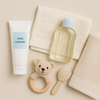
Baby skin problems – from diaper rash to eczema
4 min reading time

4 min reading time
Learn with PRO HAAR experts how to recognize and care for common baby skin problems such as diaper rash, cradle cap, and eczema.
Baby skin problems – from diaper rash to eczema
Even with the gentlest care, delicate baby skin can sometimes react.
Redness, dry patches or rashes occur in almost all babies in the first few months – it is part of the development of their skin barrier.
The experts at PRO HAAR explain which skin problems are common, what causes them and how you can gently treat and prevent them.
1. Diaper rash
The most common irritation in babies, caused by moisture, friction and ammonia in urine or feces.
Symptoms: redness, warm skin, sometimes small bumps or scales.
What helps:
✔ Change more often – at least every 2 to 3 hours.
✔ Air – let the skin breathe without a diaper.
✔ Cream with zinc oxide or panthenol – soothes and protects.
✔ Avoid wipes containing perfume or alcohol.
Professional tip from PRO HAAR: If you have sensitive skin, use a barrier cream after every change, also as a preventative measure.
2. Dry skin & flaking
After birth, the skin loses its protective layer of fat (vernix), which can cause temporary dryness.
This is normal and usually goes away on its own.
What helps:
✔ Moisturize with almond oil, shea butter, or panthenol.
✔ Bathe with oil instead of foaming soap.
✔ No synthetic clothing or perfumed detergents.
3. Mountain (cradle cap)
Yellow flakes on the scalp due to excessive sebum production combined with yeast growth.
What helps:
✔ Massage the scalp with jojoba or coconut oil and leave on for 30 minutes.
✔ Comb gently with a baby brush.
✔ Then wash with a mild, perfume-free baby shampoo.
✔ Repeat several times a week until the flakes come loose.
4. Eczema (atopic dermatitis)
One of the most sensitive skin conditions, often genetically determined.
Symptoms: dry, red patches, sometimes itching or crusting.
What helps:
✔ Daily hydration with a rich cream or lotion with ceramides .
✔ Avoid perfume, wool, overheating and foaming products.
✔ Use cotton clothing and mild detergents.
✔ Seek advice if irritation persists – sometimes medical ointment is necessary.
5. Heat rash (miliaria)
Small red dots or blisters, especially in skin folds in warm weather.
What helps:
✔ Airy cotton clothing.
✔ Keep cool, no thick blankets.
✔ Wash the skin with lukewarm water, without soap.
✔ Moisturize with a light lotion or aloe vera gel.
6. Allergic reactions
Sometimes a new detergent, lotion, or food (via breastfeeding) can cause a sudden rash.
What helps:
✔ Discontinue the suspect product.
✔ Choose hypoallergenic baby care.
✔ Soothe the skin with panthenol or oatmeal extract .
When to see a doctor?
Go to the pediatrician if:
⚠️ Rash is accompanied by fever, fluid-filled blisters or scabs.
⚠️ The baby is itchy or sleeps poorly.
⚠️ The spots do not improve within 5 days of care.
The role of prevention
✔ Keep the skin clean, but not over-washed.
✔ Hydrate daily, even without complaints.
✔ Only use products with short, transparent ingredient lists.
✔ Create a stable indoor climate – not too dry or too warm.
Conclusion – softness heals faster
Every baby's skin has its own unique sensitivities. By understanding the cause, you can take targeted and gentle action.
At PRO HAAR we believe: gentle care, rest and patience are the best medicines for happy, healthy skin.